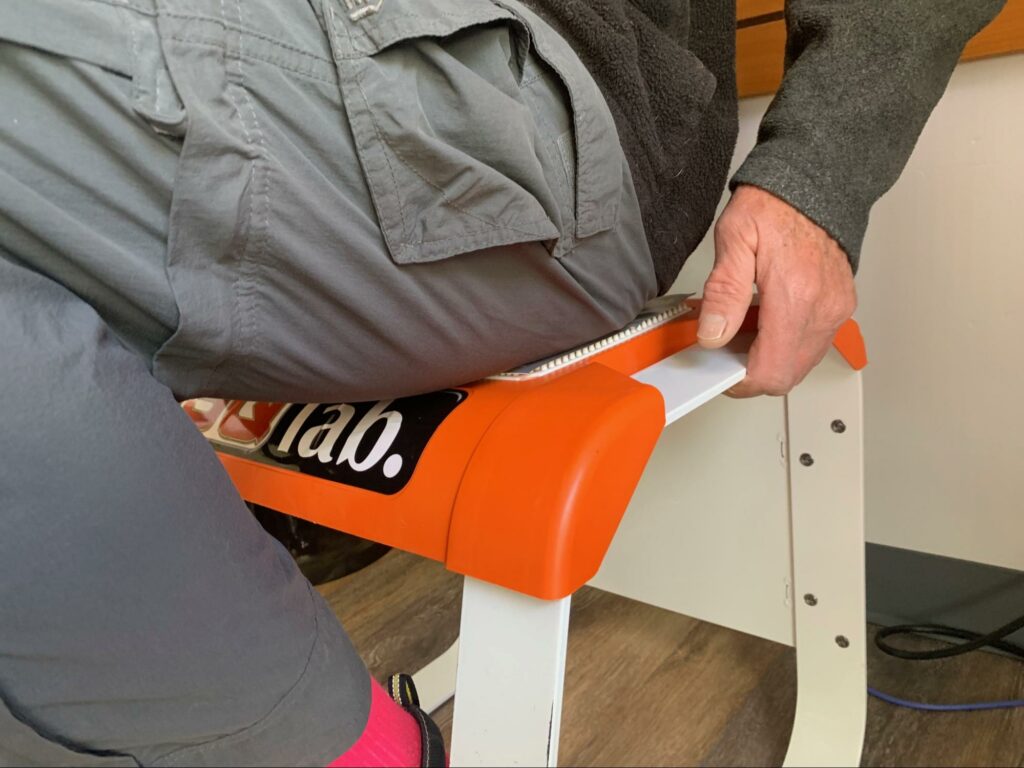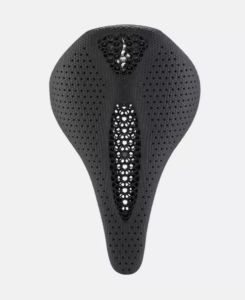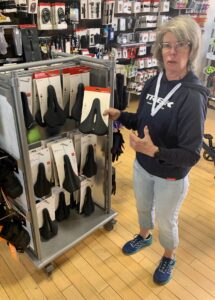A history of the humble bike saddle (and how to pick the right one)

Friday, May 5, 2023
By Ray Keener
Ahhh, the first days of Spring, when Boulder bikers come home from their first ride with sore buns, or worse. What to do?
Even seasoned cyclists get saddle sore in the early going. If you were experiencing pain in the groin last season after months of break-in, it’s time for a new saddle.
Fortunately, Boulder’s 20-plus bike retailers have a wide selection of saddles to choose from and liberal try-out policies so you can make your decision after a longer ride.
Before we give you some guidance from local experts, a little history on the evolution of the bicycle saddle. Ever wonder why it’s called a saddle rather than a seat?
Bike saddles evolved from horse saddles. Here’s a hobby horse from 1818, a precursor to the bicycle. We hadn’t gotten to pedals quite yet: You Flintstoned it.

Technoseum – State Museum of Technology and Work in Mannheim
The saddle served the same purpose as on a horse: To hold your pelvis in place while you rode. Hence the lower-in-the middle, higher-at-both-ends shape.
The safety bicycle emerged in the 1880s, looking not all that different from our single-speed cruisers today. The solutions to saddle discomfort were varied and ingenious. Here’s a popular $4 model with a novel wicker solution to perineal pain.


As with many technical innovations from today, there’s nothing much new under the sun. Here’s the Specialized Mirror women’s saddle, with the wicker being replaced by 3D printed polymers, to gain research-proven relief at $450.
Once the Golden Age of bicycle innovation passed, Americans came to view bikes as a toy for kids. Adult rides along the lines of a Raleigh three-speed had cushy spring saddles and were generally used for short hops where saddle comfort was a non-issue.
This all changed during the Bike Boom of 1971-74, when Baby Boomers bought 10-speeds to save gas and the planet. Bicycle touring became a popular pastime, and sore buns were endemic.
When riders complained of pain, bike shop people (I was one) told them, “Keep riding, you’ll get used to it.” Partly because we veteran cyclists had gotten used to it; partly because there were no good alternatives to the cheap factory saddle.
The Hoffacker brothers, Bud and Neal, stepped into the breach. They started Avocet, an innovative company upstairs from their family-owned shop, Palo Alto Bicycles. They also created the first digital bike computer and the first treadless road tires.
In 1977, they came to Boomer bottom rescue with the Avocet Touring saddle, a patented two-bumped design. Slightly wider, the saddle featured thicker padding for comfort on day-long rides. Avocet also marketed the first women’s-specific saddle.
Not only did the saddles sell well, Avocet’s marketing also pioneered matching up your pelvic anatomy with your saddle. Up until then, we had never heard of “ischial bones,” the pelvic protrusions that contact the saddle rearward.

Avocet was first to market, and what followed was a torrent of new designs and products that rivaled the early 1900s and continues to this day — much to the delight of cyclists who would rather address the pain than “get used to it.”
Long-time Boulder resident Andy Pruitt has led the development of saddle technology for the past two decades. In his former consulting relationship with Specialized, he designed their Body Geometry saddles, generally considered the industry benchmark.
Going beyond trial-and-error methods, Pruitt developed a testing methodology using transparent saddles, video cameras and brave nude volunteers to observe what’s really going on “down there” as a cyclist pedals. Here’s the tech from Andy (and here’s the entertaining version).
We spoke to Pruitt to gain some tips for choosing the right saddle. “Watch people saddle shopping, the first thing they do is press their thumb into it,” Pruitt noted. “That’s a poor way to choose.”
“Soft saddle foam and gel feel cushy, and they want to push back and return to their original shape,” he continued. “This starves your tissues of capillary supply, just like a really hard saddle will. You get the same ischemic [blood-starved] result either way.”
“You really need to put the saddle on your bike and take a longer ride, not just a spin around the parking lot,” he emphasized. “Our local shops are really good about helping you, and you need to be sensitive to the time they spend. Go saddle shopping on a rainy Tuesday, not a sunny Saturday.”
Pruitt stressed the relationship between choosing a saddle and making sure your bike is adjusted for proper fit.
“The right saddle in the wrong place is just as bad as the wrong saddle in the right place,” he said. Of the three variables to saddle position, the angle or tilt to the saddle is the best place to start.
Too tilted back and you’ll create too much pressure on your soft tissues from the nose. Too tilted downward and you’ll constantly be sliding forward and then pushing yourself back into position. Start with a level saddle. If it hurts when it’s level, you’re likely on the wrong one.

“A shop that doesn’t do bike fits is usually not a good place to buy a saddle,” Pruitt said. “And neither is the internet. You need an experienced human to help you. If you’re a woman, it’s probably best to seek out female help.”
We sought, and we found. Amy Farnsworth works at Trek Bicycle Boulder at Broadway and Baseline. She passes the “experienced” test; she started at High Wheeler on Pearl St. in 1987. She finds that the most common male complaint is numbness from pressure on the perineal nerves, while women suffer more from sit bone pain than from soft tissue discomfort.
She concurs with Pruitt regarding bike fit.
“Often, people have their saddles set too high, which increases the pressure from rocking back and forth,” she said. “It’s impossible to separate bike fit issues from saddle pain. You have to address them both together.”

The Bontrager saddle Farnsworth is holding costs $37.
“Cost and comfort don’t necessarily go together,” she said. “The main thing is getting the correct saddle width and a proper trial ride. If the saddle company doesn’t offer a 30-day comfort guarantee, you should try another shop.”
One more tool to get the right saddle fit: measuring devices to find the distance between your ischial or sit bones. Early versions had a gel pad to sit on and measure the distance between the depressions. Now there are digital pressure-mapping devices that achieve the same end.
Many saddles now come marked with the ideal ischial spacing. Common widths are 130, 143 and 155 millimeters. There’s some but not complete correlation between your body size, gender and ischial spacing. Fortunately, you can measure instead of guess.
Zinn Cycles in Louisville sells the SQ Labs brand of saddles. Their system involves placing a sheet of paper on a bench covered with little spines that poke holes in the paper.
“The great thing about this, you can take the results with you,” Lennard Zinn told us. Note that Zinn is 6’7” and his ischial spacing is narrower than the narrowest 130 saddle he sells.
Bottom line, there’s hope for your sore bottom. The days of “grin and bear it” are over. So take your bike to your favorite shop. Relief is one nice, long test ride away!

— Ray Keener opened a bike shop in 1975 and has enjoyed many industry roles since. He is currently Retail Editor of Bicycle Retailer magazine/website and manages projects at PeopleForBikes. Locally, he volunteers with Community Cycles and does bike fits on Saturday mornings.
Want more stories like this, delivered straight to your inbox?
Transportation bike bike fit biking Boulder cycling Lennard Zinn Ray Keener saddle Specialized Trek
Sign up for a weekly newsletter from Boulder Beat.
Transportation bike bike fit biking Boulder cycling Lennard Zinn Ray Keener saddle Specialized Trek


Amy at Trek Boulder is AWESOME!
The ideal sitting position depends greatly on the type of riding. However, common position is sitting on the crook of the saddle to have equal distribution and avoid too much pressure on your sit bones.